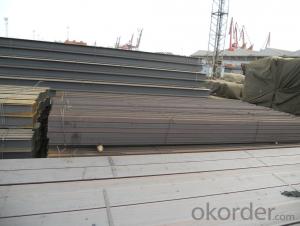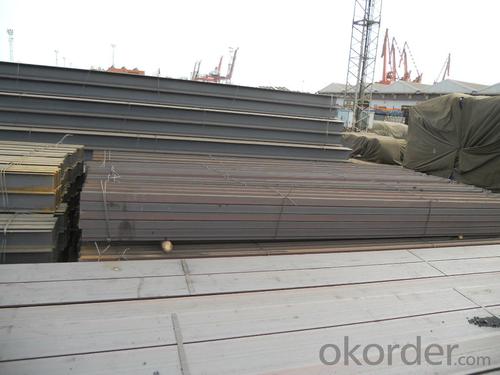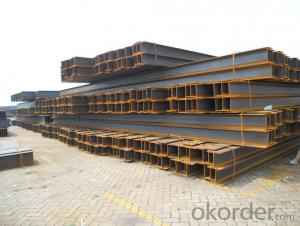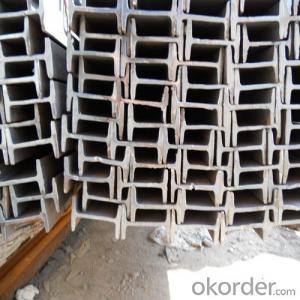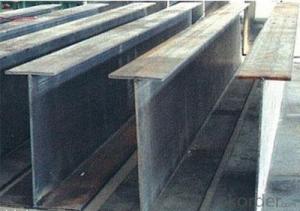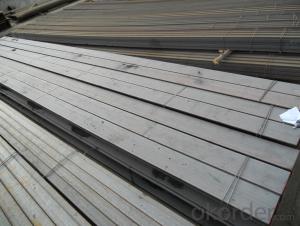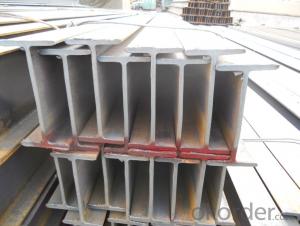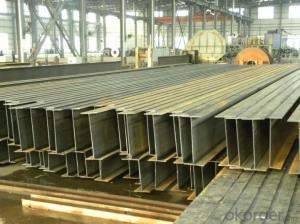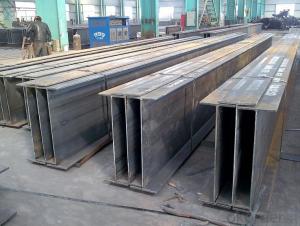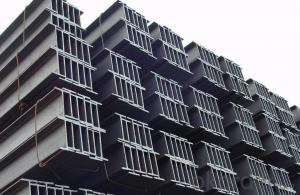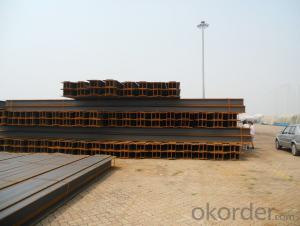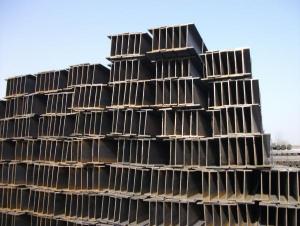Japanese Standard SS400 H beam with High Quality 294mm-300mm
- Loading Port:
- China main port
- Payment Terms:
- TT or LC
- Min Order Qty:
- 100 m.t
- Supply Capability:
- 15000 m.t/month
OKorder Service Pledge
OKorder Financial Service
You Might Also Like
Specifications of Japanese Standard SS400 H beam with High Quality 294mm-300mm:
1. Standard: JIS 3192
2. Grade: SS400 or Equivalent
3. Length: 10m, 12m as following table
4. Invoicing on theoretical weight or actual weight as customer request
5.Payment: TT or L/C
Size and Mass of Japanese Standard SS400 H beam with High Quality 294mm-300mm:
| Size (mm) | Mass (Kg/m) | Size (mm) | Mass (Kg) |
| 298*149*5.5 | 32.0 | 294*200*8.0 | 55.8 |
| 300*150*6.5 | 36.7 | 294*302*12.0 | 83.4 |
Usage of Japanese Standard SS400 H beam with High Quality 294mm-300mm:
(1). for the plant, high-rise building construction
(2). for the bridge, shipment building
(3).for lifting and transportation machinery, equipment manufacturing base building
(4). for the support, foundation pile manufacturing
FAQ:
Q1: Why buy Materials & Equipment from OKorder.com?
A1: All products offered by OKorder.com are carefully selected from China's most reliable manufacturing enterprises. Through its ISO certifications, OKorder.com adheres to the highest standards and a commitment to supply chain safety and customer satisfaction.
Q2: How do we guarantee the quality of our products?
A2: We have established an advanced quality management system which conducts strict quality tests at every step, from raw materials to the final product. At the same time, we provide extensive follow-up service assurances as required.
Q3: How soon can we receive the product after purchase?
A3: Within three days of placing an order, we will arrange production. The shipping date is dependent upon the quatity, how many sizes you want and the plan of production, but is typically 1 month to 2 months days from the beginning of production.
Images of Japanese Standard SS400 H beam with High Quality 294mm-300mm:
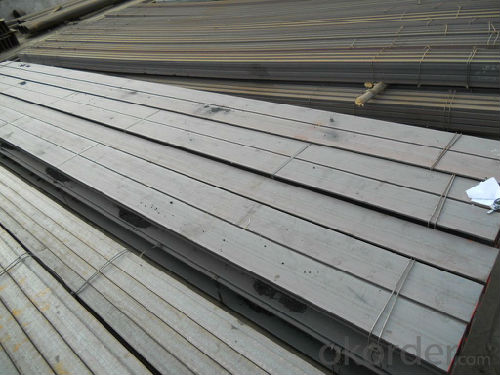
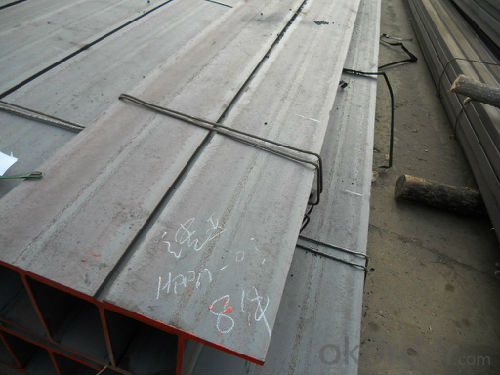
* If you would like to get our price, please inform us the size, standard/material and quantity. Thank you very much for your attention.
- Q: Can steel H-beams be used for shopping malls or retail complexes?
- Yes, steel H-beams can be used for shopping malls or retail complexes. Steel H-beams are commonly used in construction due to their strength and durability. They provide structural support, making them suitable for large-scale projects like shopping malls or retail complexes. Steel H-beams can bear heavy loads, allowing for the construction of wide-span structures, which is ideal for open floor plans often found in commercial spaces. Additionally, steel is fire-resistant, making it a safe choice for public buildings. Overall, steel H-beams are a reliable and versatile option for constructing shopping malls or retail complexes.
- Q: Can steel H-beams be used in airport hangar or aircraft maintenance facilities?
- Yes, steel H-beams can be used in airport hangars or aircraft maintenance facilities. Steel H-beams are versatile structural elements that offer excellent strength-to-weight ratio and load-bearing capabilities. They are commonly used in construction projects that require large open spaces, such as aircraft hangars and maintenance facilities. The H-shaped design of the beams provides structural rigidity and stability, making them suitable for supporting heavy loads and withstanding the dynamic forces associated with aircraft operations. Additionally, steel H-beams can be easily fabricated and installed, allowing for efficient construction and customization to meet specific design requirements. Overall, steel H-beams are a popular choice in the aviation industry due to their strength, durability, and versatility.
- Q: What are the common factors that affect the cost of steel H-beams?
- There are several common factors that can affect the cost of steel H-beams. 1. Raw material costs: The cost of the raw materials used to manufacture steel H-beams, such as iron ore and coal, can have a significant impact on the overall cost. Fluctuations in the prices of these raw materials can directly affect the cost of production and consequently the selling price of the H-beams. 2. Manufacturing process: The manufacturing process of steel H-beams involves various stages, including melting, casting, rolling, and heat treatment. The efficiency and complexity of these processes can impact the cost. Technological advancements, energy consumption, labor costs, and equipment maintenance expenses all play a role in determining the overall manufacturing cost. 3. Market demand and supply: The demand and supply dynamics of steel H-beams can influence their cost. If there is high demand and limited supply, the prices are likely to be higher. Conversely, if there is low demand and excess supply, prices may be lower. Market conditions, construction projects, and economic factors can all affect the demand and supply of steel H-beams. 4. Transport and logistics: The cost of transporting steel H-beams from the manufacturing facility to the customer's location can impact the final price. Factors such as distance, transportation mode, fuel prices, and handling charges can all contribute to the overall cost. Additionally, import duties, taxes, and tariffs imposed by different countries can also affect the cost of steel H-beams. 5. Quality and specifications: The quality and specifications of steel H-beams can influence their cost. Higher-quality materials, superior finishes, and precise dimensions might result in higher prices. Additionally, specific requirements such as custom sizes, lengths, or special coatings can increase the cost of production and, consequently, the selling price. 6. Competition and market conditions: The level of competition in the steel industry can influence the cost of H-beams. Intense competition among manufacturers can lead to price wars and lower prices. Economic factors, global trade policies, and market trends can also impact the cost of steel H-beams. It is important to note that these factors can vary based on geographic location, industry-specific requirements, and other external factors. Consequently, the cost of steel H-beams can fluctuate over time due to changes in any or all of these factors.
- Q: What are the different types of connections used for steel H-beams in bridges?
- There are several types of connections used for steel H-beams in bridges, each designed to provide strength, stability, and durability. Some of the common types of connections include: 1. Welded Connections: This is the most common type of connection used for steel H-beams in bridge construction. Welded connections involve joining the flanges and webs of the H-beams using high-strength welding techniques. The welds are typically made using electric arc welding or more advanced methods such as submerged arc welding. Welded connections provide excellent strength and rigidity. 2. Bolted Connections: Bolted connections involve connecting the H-beams using high-strength bolts. Bolted connections are often used in situations where the H-beams need to be easily disassembled or replaced. These connections consist of pre-drilled holes in the flanges and webs of the H-beams, with bolts inserted through the holes and tightened with nuts. Bolted connections provide good strength and can be easily adjusted or replaced if needed. 3. Riveted Connections: Riveted connections were commonly used in older bridge constructions but have been largely replaced by welded and bolted connections. Riveted connections involve using hot-rivets, which are heated and inserted into pre-drilled holes in the H-beams. As the rivets cool, they contract and create a secure connection. While riveted connections offer excellent strength, they require more time and labor to install compared to other connection methods. 4. Moment Connections: Moment connections are specialized connections used in situations where the H-beams need to resist bending forces, such as in continuous beam bridges. These connections allow the H-beams to transfer moments or rotational forces between each other, providing additional stability. Moment connections are typically achieved through a combination of welding and bolting methods, ensuring optimal load transfer and structural integrity. 5. Splice Connections: Splice connections are used when longer H-beams are required for bridge construction. In such cases, two or more shorter H-beams are connected together to form a longer beam. Splice connections involve joining the flanges and webs of the H-beams using welding or bolted methods. These connections provide continuity and strength throughout the length of the beam, ensuring a seamless and structurally sound bridge. It is important to note that the selection of the connection type for steel H-beams in bridge construction depends on various factors, including the bridge design, load requirements, material availability, and construction methods. Consulting with structural engineers and adhering to industry standards and codes is crucial to ensure the appropriate connection type is chosen for a specific bridge project.
- Q: What are the different types of steel H-beam connections used in healthcare facilities?
- In healthcare facilities, various types of steel H-beam connections are commonly used to ensure the structural integrity and safety of the building. These connections not only provide support but also help in withstanding the dynamic loads and vibrations associated with healthcare operations. Some of the different types of steel H-beam connections used in healthcare facilities include: 1. Welded connections: This is the most common type of connection used in healthcare facilities. It involves welding the steel H-beams together, creating a strong and rigid connection. Welded connections are often used in areas where high load-bearing capacity is required, such as in operating rooms or intensive care units. 2. Bolted connections: Bolted connections involve using bolts and nuts to join the steel H-beams together. This type of connection allows for easier installation, inspection, and maintenance. Bolted connections are commonly used in non-critical areas of healthcare facilities, such as corridors or administrative offices. 3. Moment connections: Moment connections are designed to resist both vertical and horizontal forces. They provide increased stability and rigidity to the structure. These connections are often used in areas where the building is subjected to lateral loads, such as in emergency departments or MRI rooms. 4. Shear connections: Shear connections are primarily used to transfer lateral loads between steel H-beams. They are designed to resist shear forces and prevent the beams from sliding or separating. Shear connections are typically used in areas where the building is subjected to wind or seismic loads, such as in outpatient clinics or radiology departments. 5. Pinned connections: Pinned connections allow for rotation between the steel H-beams. These connections are commonly used in areas where structural movements or deflections are expected, such as in rehabilitation centers or physical therapy rooms. Pinned connections provide flexibility and allow the structure to accommodate loads and movements without excessive stress. It is important to note that the selection of steel H-beam connections in healthcare facilities depends on factors such as the specific building requirements, load conditions, and local building codes. Consulting with structural engineers and architects during the design and construction process ensures the appropriate selection and installation of the most suitable connections for healthcare facility structures.
- Q: What are the common safety precautions when working with steel H-beams?
- Common safety precautions when working with steel H-beams include wearing appropriate personal protective equipment (PPE) such as hard hats, steel-toed boots, safety glasses, and gloves to protect against potential hazards. It is crucial to ensure proper lifting techniques and use of equipment such as cranes or forklifts to prevent accidents due to heavy loads. Additionally, workers should be cautious about potential tripping hazards and maintain a clean and organized workspace. Regular inspections of the beams for any damage or defects should be conducted, and workers should be trained on proper procedures for cutting, welding, or handling the steel beams to minimize the risk of accidents or injuries.
- Q: Can steel H-beams be used in the construction of automotive or manufacturing plants?
- Indeed, automotive or manufacturing plants can utilize steel H-beams for their construction purposes. The prevalent usage of steel H-beams in construction stems from their remarkable strength-to-weight ratio and capacity to bear hefty loads. Their suitability for extensive structures such as automotive or manufacturing plants lies in their ability to offer robust and enduring support beams. Consequently, these beams confer stability and structural integrity upon the edifice, guaranteeing its resilience against the weight of machinery, equipment, and materials. Moreover, steel H-beams possess versatility, enabling convenient fabrication and customization to satisfy specific design requisites. Consequently, they represent an ideal selection for construction endeavors of this nature.
- Q: Can steel H-beams be used in the construction of schools or educational buildings?
- Yes, steel H-beams can be used in the construction of schools or educational buildings. Steel H-beams are commonly used in construction due to their high strength and durability. They provide structural support and stability to buildings, making them suitable for educational facilities that require long-lasting and stable structures. Additionally, steel H-beams can be prefabricated, allowing for faster construction times and cost-effectiveness, which are important factors in educational building projects.
- Q: What are the common sizes of steel H-beams available in the market?
- The common sizes of steel H-beams available in the market vary depending on the specific requirements and applications. However, some standard sizes are commonly found in the market. These sizes typically range from 100mm to 1000mm in height, with widths varying from 50mm to 500mm. The lengths of steel H-beams can also vary, but they are often available in standard lengths of 6 meters, 9 meters, or 12 meters. These common sizes cater to a wide range of construction and structural needs, allowing for flexibility and adaptability in various projects.
- Q: How do steel H-beams perform in high wind areas?
- Steel H-beams are known for their exceptional strength and durability, making them a popular choice for construction in high wind areas. These beams are designed to withstand extreme weather conditions, including strong winds, by providing a rigid and stable framework for buildings and structures. The structural design of steel H-beams enables them to efficiently distribute the wind load throughout the entire structure, minimizing any potential damage. The shape of the H-beam allows for greater load-bearing capacity, as it can better resist bending and twisting forces caused by high winds. This ensures that the beams remain stable and prevent any structural failure or collapse. Additionally, steel H-beams are commonly made from high-strength steel alloys, which further enhances their ability to withstand high winds. These alloys have superior tensile strength and elasticity, allowing the beams to flex and absorb the energy from wind gusts without permanently deforming or breaking. This flexibility helps to dissipate the wind's force and reduce the overall stress on the structure. Furthermore, steel H-beams are often installed as part of a comprehensive structural system that includes other components, such as bracing, connectors, and fasteners. These elements work together to further enhance the performance of the beams in high wind areas. Properly engineered connections and bracing systems can effectively transfer the wind load to the foundation, ensuring the overall stability and integrity of the structure. In summary, steel H-beams are well-suited for high wind areas due to their strength, rigidity, and durability. Their efficient load distribution capabilities, high-strength alloys, and compatibility with other structural components make them a reliable choice for buildings and structures in regions prone to strong winds.
Send your message to us
Japanese Standard SS400 H beam with High Quality 294mm-300mm
- Loading Port:
- China main port
- Payment Terms:
- TT or LC
- Min Order Qty:
- 100 m.t
- Supply Capability:
- 15000 m.t/month
OKorder Service Pledge
OKorder Financial Service
Similar products
Hot products
Hot Searches
Related keywords
